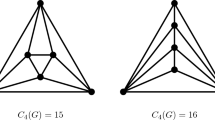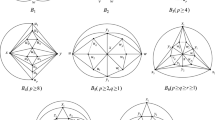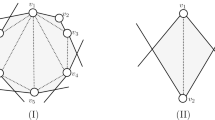Abstract
A graph is hamiltonian if it has a hamiltonian cycle. It is well-known that Tutte proved that any 4-connected planar graph is hamiltonian. It is also well-known that the problem of determining whether a 3-connected planar graph is hamiltonian is NP-complete. In particular, Chvátal and Wigderson had independently shown that the problem of determining whether a maximal planar graph is hamiltonian is NP-complete. A classical theorem of Whitney says that any maximal planar graph with no separating triangles is hamiltonian, where a separating triangle is a triangle whose removal separates the graph. Note that if a planar graph has separating triangles, then it can not be 4-connected and therefore Tutte's result can not be applied. In this paper, we shall prove that any maximal planar graph with only one separating triangle is still hamiltonian.
Similar content being viewed by others
References
T. Asano, S. Kikuchi and N. Saito, “A linear algorithm for finding hamiltonian cycles in 4-connected maximal planar graphs,” Disc. Appl. Math., vol. 7, pp. 1-15, 1984.
G. Chartrand and L. Lensniak, Graph and Digraphs, Wadsworth: Monterey, CA, 1981.
N. Chiba and T. Nishizeki, “The Hamilton cycle problem is linear-time solvable for 4-connected planar graphs,” J. Algorithms, vol. 10, pp. 187-211, 1989.
V. Chvátal, “Hamiltonian cycles,” The Traveling Salesman Problem, John Wiley & Sons: NY, 1985, p. 426.
M.B. Dillencourt, “Hamiltonian cycles in planar triangulations with no separating triangles,” J. Graph Theory, vol. 14, pp. 31-49, 1990.
M.B. Dillencourt, “Polyhedra of small order and their hamiltonian properties,” J. Comb. Theory, Series B, vol. 66, pp. 87-122, 1996.
M.R. Garey, D.S. Johnson, and R.E. Tarjan, “The planar Hamiltonian circuit problem is NP-complete,” SIAM J. Comput., vol. 5, pp. 704-714, 1976.
S.L. Hakimi and E.F. Schmeichel, “On the connectivity of maximal planar graphs,” J. Graph Theory, vol. 2, pp. 307-314, 1978.
T. Nishizeki, “A 1-tought nonhamiltonian maximal planar graph,” Disc. Math., vol. 30, pp. 305-307, 1980.
T. Nishizeki and N. Chiba, Planar Graphs: Theory and Algorithms, North-Holland Mathematics Studies 140, Annals of Discrete Mathematics, vol. 32, p. 7, 1988.
W.T. Tutte, “A theorem on planar graphs,” Trans. Amer. Math. Soc., vol. 82, pp. 99-116, 1956.
D.B. West, Introduction to Graph Theory, Prentice Hall: Upper Saddle River, NJ, 1996.
H. Whitney, “A theorem on graphs,” Ann. Math., vol. 32, pp. 378-390, 1931.
H. Whitney, “Congruent graphs and the connectivity of graphs,” Amer. J. Math., vol. 54, pp. 150-168, 1932.
Author information
Authors and Affiliations
Rights and permissions
About this article
Cite this article
Chen, C. Any Maximal Planar Graph with Only One Separating Triangle is Hamiltonian. Journal of Combinatorial Optimization 7, 79–86 (2003). https://doi.org/10.1023/A:1021998507140
Issue Date:
DOI: https://doi.org/10.1023/A:1021998507140




